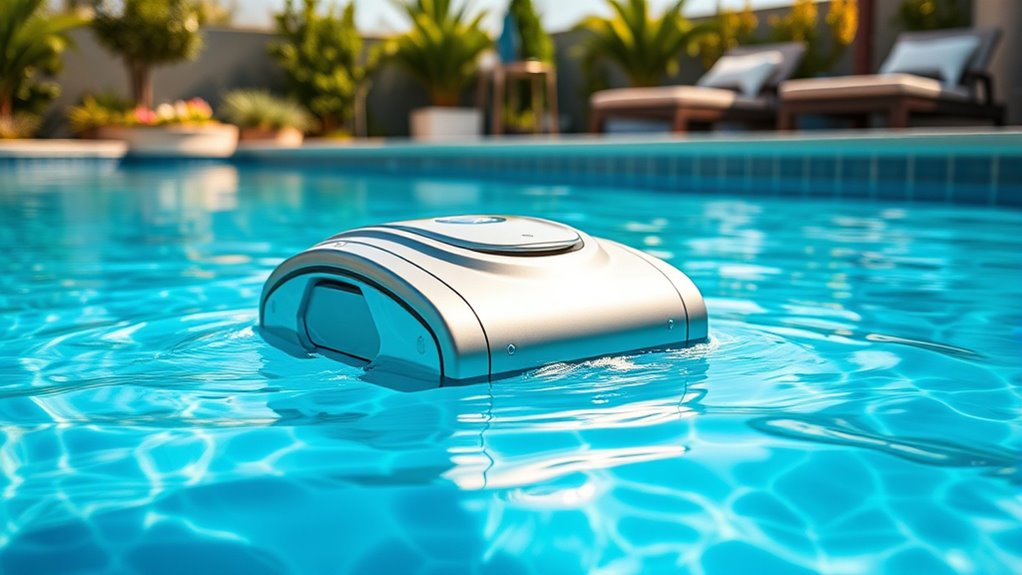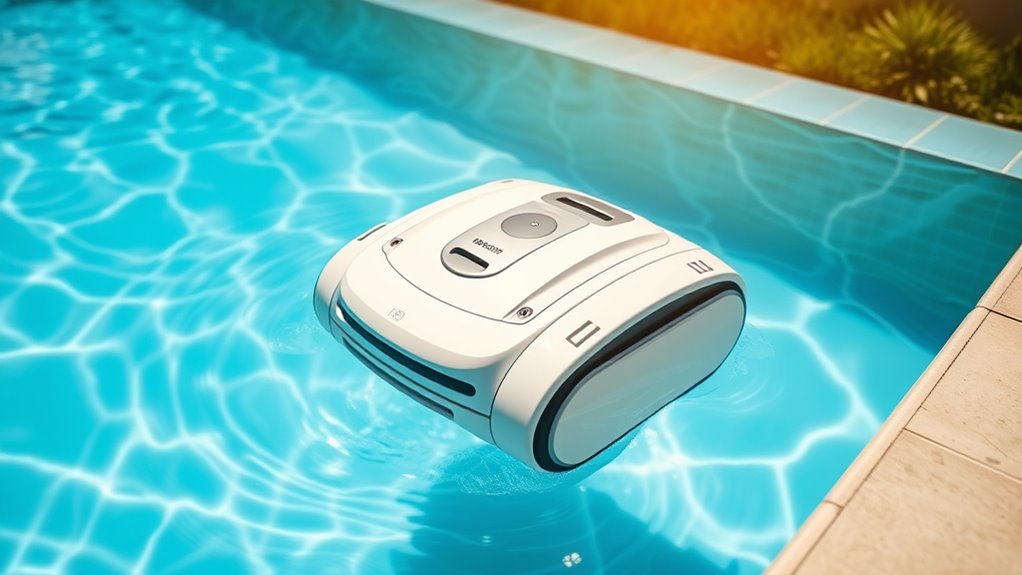Robotic pool cleaners are generally worth the investment if you value convenience, time savings, and energy efficiency. They eliminate manual cleaning, adapt to various pool shapes, and are easy to set up, making maintenance much simpler. While the upfront costs can be high, their advanced features like smart integration and eco-friendly operation can justify the expense. Curious about how they compare to traditional methods and if they’re right for you? Keep exploring to find out more.
Key Takeaways
- Robotic pool cleaners offer significant convenience by automating cleaning, saving time and effort.
- Advanced models feature smart integration, real-time diagnostics, and energy-efficient operations, enhancing value.
- High initial costs may be offset by long-term savings on professional cleaning and reduced chemical use.
- Growing market and technological innovations indicate increasing reliability and performance over traditional methods.
- Compatibility with various pool types and ease of setup make them a versatile, worthwhile investment for many homeowners.

Robotic Pool Cleaners
Are robotic pool cleaners revolutionizing how we maintain pools? Absolutely. These devices are transforming the way homeowners and businesses keep their pools clean and hygienic. The global market for robotic pool cleaners was valued at roughly USD 685 million to USD 740 million in the early 2020s. Experts project this figure soaring to between USD 2.48 billion and USD 5.18 billion by 2030-2032, with an impressive compound annual growth rate (CAGR) of around 14% to 16.5%. North America currently holds the largest share, approximately 42%, thanks to higher disposable incomes and early adoption of smart home tech. Meanwhile, Asia-Pacific is emerging rapidly as urbanization and rising incomes boost demand.
Technological advancements are at the core of this growth. Modern robotic cleaners now seamlessly integrate with smart home ecosystems, allowing you to control them remotely via apps or voice commands. AI-powered models analyze pool shapes and debris types, adjusting their cleaning patterns to maximize efficiency. IoT capabilities enable real-time monitoring, diagnostics, and even predictive maintenance, reducing downtime and long-term costs. Many models now feature energy-efficient motors and eco-friendly materials, making them more environmentally friendly and cost-effective over time. In addition, these innovations aim to improve cleaning performance, autonomy, and versatility, making pool maintenance less burdensome.
Modern robotic pool cleaners leverage AI, IoT, and smart integrations to boost efficiency and ease pool maintenance.
Several factors drive this market surge. Convenience plays a huge role; you no longer need to manually scrub or supervise your pool’s cleaning process. Rising awareness of hygiene and pool maintenance deepens demand, especially as more people invest in residential and commercial pools for leisure and wellness. Increasing disposable income makes these devices more accessible and appealing. Consumers want low-maintenance, reliable solutions that save time and energy—qualities robotic cleaners excel at providing. They are designed for easy setup, with components like motors, polyester filters, onboard pumps, and remote controls that simplify operation. Many models are compatible with various pool shapes, primarily focusing on in-ground pools but adaptable to others. Furthermore, ongoing innovations in design and efficiency are making these devices even more attractive to a broad range of consumers.
However, challenges remain. The initial cost can be high, deterring some buyers who are price-sensitive. Competition from traditional cleaning methods and skepticism about long-term reliability also influence purchasing decisions. Some users find smart system integration complex, and seasonal demand fluctuations can impact sales in different regions. Despite these hurdles, the market continues to grow, especially in North America and Asia-Pacific, driven by urbanization, middle-class expansion, and sustainability policies. Understanding the features and benefits of different models can help consumers make better-informed choices.
Leading brands like Maytronics, Hayward, iRobot, and Pentair are innovating rapidly, offering increasingly sophisticated and energy-efficient options. If you’re considering investing in a robotic pool cleaner, the technological advancements, market growth, and consumer demand suggest it’s a worthwhile investment—saving you time, effort, and money in the long run.
Frequently Asked Questions
How Long Do Robotic Pool Cleaners Typically Last?
You’re wondering how long robotic pool cleaners last. Typically, they endure around 4 to 7 years, depending on usage and maintenance. With proper care, some can last over a decade, especially premium models. Regular cleaning, storing them properly, and avoiding harsh chemicals help extend their lifespan. Investing in quality brands and performing timely repairs can keep your robot running smoothly for many years, making it a worthwhile purchase.
Are Robotic Pool Cleaners Suitable for All Pool Types?
You might wonder if robotic pool cleaners suit your pool type. The good news is, they’re generally compatible with most pools, including fiberglass, vinyl liner, in-ground, and above-ground models. They work independently of plumbing, making them versatile. Just guarantee you choose a model with the right features—like soft bristles for delicate surfaces or advanced navigation for irregular shapes—to keep your pool clean without damage.
What Maintenance Do Robotic Pool Cleaners Require?
You need to regularly maintain your robotic pool cleaner to keep it running smoothly. Empty and rinse the filter basket after each use, check and clean brushes and wheels weekly, and inspect the exterior for damage. Keep the battery and electrical connections dry, store it properly away from sunlight, and follow a consistent cleaning schedule. Monitoring its performance helps catch issues early, ensuring your cleaner stays effective and prolongs its lifespan.
Do Robotic Pool Cleaners Work in Large or Deep Pools?
Think of a robotic pool cleaner as a trusty diver, expertly maneuvering your pool’s depths. It works well in large or deep pools, thanks to powerful motors, long cords, and advanced navigation. Wall-climbing features help it scrub vertical surfaces, and high filtration rates handle debris efficiently. While some models may struggle with very deep or irregularly shaped pools, many are designed to keep your big pool sparkling effortlessly, saving you time and effort.
Can Robotic Pool Cleaners Be Used With Saltwater Pools?
Yes, robotic pool cleaners can be used with saltwater pools. Most modern models are designed to handle saline conditions, featuring corrosion-resistant materials and saltwater-compatible components. You should verify compatibility prior to purchasing, but brands like Dolphin and Maytronics ensure full functionality in saltwater environments. Regular maintenance, such as cleaning filters and brushes, helps prolong the cleaner’s life and keeps your pool spotless without damage from the salt.
Conclusion
So, are robotic pool cleaners worth it? Imagine turning your backyard oasis into a pristine paradise without lifting a finger. With their advanced technology, they save you time, effort, and even money in the long run. Don’t let the beauty of a sparkling pool slip away—embrace the future of effortless cleaning. After all, isn’t your peace of mind worth a small investment? plunge in and let technology do the dirty work for you.









